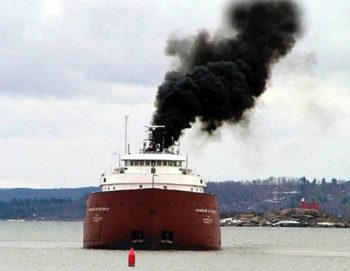
The trillion-dollar global shipping industry may soon be forced to curb greenhouse gas emissions under new rules backed by the European Union and China.
Over 200 representatives convened last week at the International Maritime Organization (IMO), the United Nations shipping supervisor based in London, to discuss regulation that could turn their industry, currently responsible for as much as 3 percent of the world’s emissions, into a zero-carbon operation by the second half of the century.
The shift toward clean power was prompted by the Paris climate agreement, as well as the threat of regional rules being considered by the EU and tested in China. Europe has proposed a plan to add ship emissions to its trading system by 2023 if the IMO talks don’t succeed. China is piloting a similar program that includes Shanghai’s ports and shipping industry.
The EU proposal “sets a deadline for the IMO to introduce a target and measures,” said Sotiris Raptis, senior adviser to the European Sea Ports Organization and former EU parliamentary adviser. “But it’s a global industry, it’s difficult to regulate emissions generated outside of jurisdiction.”
Imposing emissions would close a loophole left by the 2015 Paris climate agreement. Ship engines almost always burn heavy fuel oil, one of the dirtiest and cheapest forms of energy. IMO members will return to discuss their strategy and level of ambition in October. An agreement could be drafted by next year and implemented in 2023.
“We’re seeing that delegates are willing to discuss matters,” said Edmund Hughes, head of air pollution and energy efficiency at the IMO.
The loudest voices at the talks are small Pacific states such as the Marshall and Solomon islands and Kiribati, which are among the most vulnerable to rising seas from climate change. Some islands could be submerged by water as soon as the next decade, prompting them to form a coalition with some EU countries to seek strict IMO emission rules.
“The sector needs to urgently step up its efforts,” said Mike Halferty, transport minister of the Marshall Islands, which has the most ships registered under its flag. “If international shipping was a country, it would have the seventh-largest emissions in the world.”
China and India, the world’s two most populous nations, submitted a joint document supporting a switch to lower-carbon shipping. Under their plan, countries would be free to create individualized emission reduction plans.
Oil-producing countries such as Saudi Arabia and the United Arab Emirates emphasized that a compromise would be necessary, according to statementson Wednesday that signaled unwillingness to readily agree on proposed measures. Delegates from South American nations including Argentina and Chile said the cost impacts of long-haul trade from geographically-remote ports need to be considered.
“We’re still seeing significant disagreement among major economies over a CO2 reduction target for the sector, but we are hearing clear signals on the need to invest in and develop alternative low carbon fuels and new technologies to accelerate decarbonization,” said Bill Hemmings, director of shipping and aviation at Brussels-based NGO Transport & Environment, who is observing talks at the IMO this week.
Member states are beginning to agree to switch to cleaner fuels, according to Tristan Smith, a lecturer at University College London’s energy institute and former naval architect.
“What we’re seeing for the first time at these talks is a collective focus on alternative fuels,” Smith said. “Previously, member states typically backed efficiency measures. Technology is not the problem, it’s been a political-will problem.”
Norway and Finland are among the leaders in the transition, and have begun to operate ferries with batteries. Lithium-ion pack maker Leclanche SA recently got its 4.3-megawatt maritime battery approved by DNV GL, clearing the way for the market to grow. Royal Dutch Shell Plc is making a big bet on hydrogen to power ships. Emissions-free nuclear propulsion has long been used by warships and ice breakers and the IMO has studied atomic power for cargo vessels.
With global trade expected to nearly double by 2030, according to a study by PricewaterhouseCoopers LLP, the task to reign in emissions from shipping — which carries about 90 percent of the world’s goods — will become more important. If left unchecked, the industry could account for 17 percent of the world’s carbon emissions by 2050, according to research from the European Parliament.
That in turn would make achieving Paris accord’s goal to keep global warming well below 2 degrees Celsius (3.6 degrees Fahrenheit) even more elusive.
Copyright Ships & Ports Ltd. Permission to use quotations from this article is granted subject to appropriate credit given to www.shipsandports.com.ng as the source.
